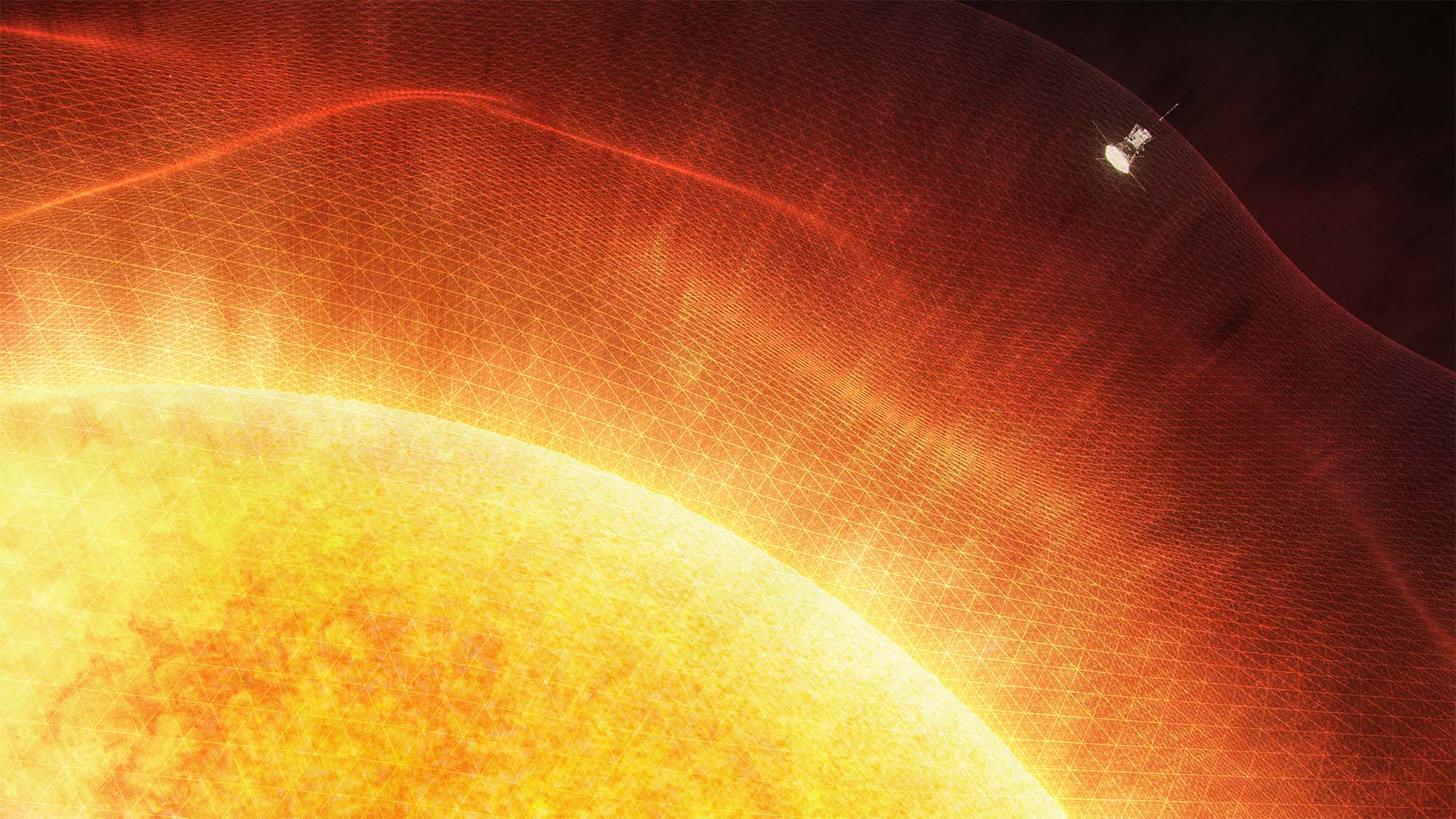We just touched the Sun for the first time in human history
NASA's Parker Solar Probe just flew through the Sun's corona

A spacecraft just touched the Sun for the first time in human history.
The Parker Solar Probe first flew through the Sun's outer layer known as the corona on April 28, 2021, collected particles and measured the Sun's magnetic field according to NASA. The announcement was publish in a paper in the Physical Review Letters on December 14.
"Parker Solar Probe 'touching the Sun' is a monumental moment for solar science and a truly remarkable feat," said Thomas Zurbuchen, associate administrator for the Science Mission Directorate at NASA Headquarters in Washington, DC.
"Not only does this milestone provide us with deeper insights into our Sun's evolution and its impacts on our solar system, but everything we learn about our own star also teaches us more about stars in the rest of the universe.
The Sun isn't a solid ball in space, but rather a densely gathered soup of plasma with a thin outer layer akin to an atmosphere known as the corona. The corona is where material blowing off of the Sun is still within the Sun's magnetic pull, so it cannot escape into space.
Like a rocket leaving Earth though, if solar material blows off into space fast enough it can escape the corona and instead becomes solar wind, escaping into the wider solar system.
Because of this, the dividing line between corona and solar wind isn't as clear as simply drawing a circle around the face of the Sun and calling it a day. The actual boundary of the Sun's outer layer is known as the Alfvén Critical Surface (ACS), and until now, it wasn't clear where the ACS actually lay.
Get daily insight, inspiration and deals in your inbox
Sign up for breaking news, reviews, opinion, top tech deals, and more.
Touching the Sun
By taking remote images of the corona (the bright, somewhat spikey bits around the moon that you can see during a solar eclipse) along with other data, scientists have estimated that it stretches anywhere from 10 to 20 solar radii from the surface of the Sun, or about 4.3 to 8.6 million miles.
The Parker Solar Probe has been on a tightening spiral trajectory around the Sun since it launched in 2018, and on its eighth go around at about 18.8 solar radii, it encountered key magnetic and particle conditions that signaled it had crossed the ACS and entered the Sun's corona.
The probe's first passage though the corona only lasted for a few hours, but as the 11-year solar cycle begins to intensify, the corona will expand outward, giving the probe many more opportunities to fly through it again.
“We were fully expecting that, sooner or later, we would encounter the corona for at least a short duration of time,” said Justin Kasper, University of Michigan professor and deputy chief technology officer at BWX Technologies, as well as the lead author of this week's paper announcing the milestone. “But it is very exciting that we’ve already reached it.”
During the solar flyby, the Parker Solar Probe also passed through the corona several times, proving that the ACS isn't a smooth shell, but rather filled with ripples, spikes, and valleys. Determining how these irregularities line up with solar activity on the surface might be key to determining how events on its surface affect the corona and ultimately the solar wind.
“Flying so close to the Sun, the Parker Solar Probe now senses conditions in the magnetically dominated layer of the solar atmosphere – the corona – that we never could before,” said Nour Raouafi, Parker project scientist at Johns Hopkins Applied Physics Laboratory in Maryland.
“We see evidence of being in the corona in magnetic field data, solar wind data, and visually in images. We can actually see the spacecraft flying through coronal structures that can be observed during a total solar eclipse.”
On its eighth flyby of the Sun, the Parker Solar Probe came within just under 15 solar radii from the surface, and it is expected to eventually come within 8.86 solar radii of its surface. Its next flyby is scheduled for January 2022 where it will likely pass through the corona again.
“I’m excited to see what Parker finds as it repeatedly passes through the corona in the years to come,” said division director for the Heliophysics Division at NASA Headquarters, Nicola Fox. “The opportunity for new discoveries is boundless.”
How is the Parker Solar Probe able to get this close to the Sun's surface?
The Parker Solar Probe was launched to study the Sun from closer than any probe before by orbiting very close to its surface. It is able to survive thanks to a thermal shield made of an advanced carbon-composite material that can withstand temperatures up to 2,500 degrees Fahrenheit (1,377 degrees Celsius).
This has the effect of cutting through the Sun's heat like a racecar breaks up the air in front of it, creating a draft behind it. In the space behind the racecar, another car encounters less wind resistance and can actually accelerate faster than if it were in front.
Similarly with the Parker Solar Probe, its thermal shield pushes the heat away, leaving the probe and it's instruments behind it to experience a much more manageable temperature that won't melt all of its instruments.

John (He/Him) is the Components Editor here at TechRadar and he is also a programmer, gamer, activist, and Brooklyn College alum currently living in Brooklyn, NY.
Named by the CTA as a CES 2020 Media Trailblazer for his science and technology reporting, John specializes in all areas of computer science, including industry news, hardware reviews, PC gaming, as well as general science writing and the social impact of the tech industry.
You can find him online on Bluesky @johnloeffler.bsky.social